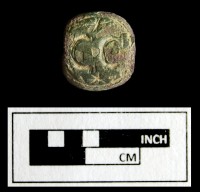 A brass signet ring bearing the initials “CC” has been unearthed at the Zekiah Fort archaeological site in Waldorf, Maryland. Students from St. Mary’s College of Maryland led by anthropology professor Julia King discovered the 17th century ring on June 13th during a six week excavation that has turned up, among other artifacts, glass trade beads, lead shot, gunflints, arrowheads and pipes. The ring is highly distinctive, and King believes it either belonged to Charles Calvert, 3rd Baron Baltimore, Governor and Proprietor of Maryland, or it was a diplomatic gift in his name.
A brass signet ring bearing the initials “CC” has been unearthed at the Zekiah Fort archaeological site in Waldorf, Maryland. Students from St. Mary’s College of Maryland led by anthropology professor Julia King discovered the 17th century ring on June 13th during a six week excavation that has turned up, among other artifacts, glass trade beads, lead shot, gunflints, arrowheads and pipes. The ring is highly distinctive, and King believes it either belonged to Charles Calvert, 3rd Baron Baltimore, Governor and Proprietor of Maryland, or it was a diplomatic gift in his name.
Since the discovery, King and her colleagues and students have been studying historical records to determine its origins and have been unable to tie it to anyone besides Calvert. She believes that the ring was used as a diplomatic gift by a representative of Calvert’s to the Indians, as a gesture of good will. The archaeologists hope to do more work at the site and learn more about the history of the ring though records and studying the remains of other structures and artifacts.
“We don’t think that Charles Calvert went up there,” King said. “He’s sending his counselors, diplomats, his rangers, carrying this ring as a gift.”
So far all the research into the historical record has returned no other likely candidate for the CC initials, and given his direct involvement in the settlement of Zekiah Fort, the context strongly suggests this ring was his, if not a personal accessory then one created as a token for his representatives to use a gift.
 Zekiah Fort was a settled by the Piscataway Indians in 1680 when they were forced to leave their ancestral lands north of the Potomac River. The English colonists had been significantly encroaching on their territory for more than 20 years, and conflicts with the neighboring Susquehannock and Seneca drove the Piscataway into Charles County in southern Maryland. Baltimore had the fort built ostensibly as a refuge for about 320 Piscataway, but it’s no coincidence that English settlers, not rival Native Americans, promptly moved onto the lands of the displaced.
Zekiah Fort was a settled by the Piscataway Indians in 1680 when they were forced to leave their ancestral lands north of the Potomac River. The English colonists had been significantly encroaching on their territory for more than 20 years, and conflicts with the neighboring Susquehannock and Seneca drove the Piscataway into Charles County in southern Maryland. Baltimore had the fort built ostensibly as a refuge for about 320 Piscataway, but it’s no coincidence that English settlers, not rival Native Americans, promptly moved onto the lands of the displaced.
The location of the fort was lost until 2011 when researchers from St. Mary’s College of Maryland and the College of Southern Maryland poring through historical documents identified the spot as a field that was a fortuitous island surrounded by development. The 100-acre site — complete with woods and historic trails as well as the fort site — was bought by Charles County in 2012. Grants from the Maryland Historical Trust and the Charles County Board of Commissioners funded this summer’s archaeological excavation.
All the artifacts will be sent to state experts for conservation. If the ring can be confirmed to have belonged to Charles Calvert or to have been a diplomatic gift from him, it will be one of very few personalized Calvert artifacts found in Maryland. Although Charles’ grandfather George Calvert, 1st Baron Baltimore, did all the work to secure the charter to the land north of the Potomac River on either side of the Chesapeake Bay, he died a few weeks before it was issued. His son Cecilius or Cecil received the proprietorship in his stead but he ruled from across the Atlantic, never stepping foot in Maryland. Cecil made his 24-year-old son Charles his deputy governor and after his father death in 1675, Charles became the governor and proprietor. He was the first Calvert to take possession of Maryland in person. (Leonard Calvert, Cecil’s brother acted as deputy on site as well, but he was never a Proprietor.)
This is why Calvert family artifacts are hen’s teeth rare, and why the ring could be of immense historical significance.